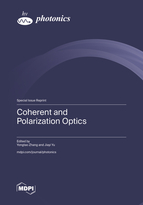Coherent and Polarization Optics
A special issue of Photonics (ISSN 2304-6732).
Deadline for manuscript submissions: closed (30 April 2023) | Viewed by 19714
Special Issue Editors
Interests: coherence; partially coherent; polarization; propagation; turbulence
Special Issues, Collections and Topics in MDPI journals
Interests: optical singularity; orbital angular momentum; partially coherence; propagation property; coherence structure
Special Issues, Collections and Topics in MDPI journals
Special Issue Information
Dear Colleagues,
Coherence and polarization are two of the intrinsic properties of a light field. The theory of optical coherence and polarization has been effectively developed over the past few decades. Extensive research has shown that both of them play a crucial role in determining the light beam propagation and light-matter interaction. The manipulation of coherence and polarization has been recognized as an available method to produce many peculiar physical phenomena, which can be superior in some of these applications, such as free-space optical communications, microdensitometry, optical information processing, and plasmonics. This Special Issue aims to discuss the latest advances on coherent and polarization optics. Although recent interest in the manipulation of coherence and polarization has been increasing and many structured light beams with prescribed distribution of coherence or polarization have been synthesized, most of them have been limited to one-dimensional control. The combination of coherence and polarization may produce novel and beneficial effects. Therefore, this Special Issue encourages discussions on many novel physical features caused by the joint manipulation of optical coherence and polarization.
Dr. Jiayi Yu
Prof. Dr. Yongtao Zhang
Guest Editors
Manuscript Submission Information
Manuscripts should be submitted online at www.mdpi.com by registering and logging in to this website. Once you are registered, click here to go to the submission form. Manuscripts can be submitted until the deadline. All submissions that pass pre-check are peer-reviewed. Accepted papers will be published continuously in the journal (as soon as accepted) and will be listed together on the special issue website. Research articles, review articles as well as short communications are invited. For planned papers, a title and short abstract (about 100 words) can be sent to the Editorial Office for announcement on this website.
Submitted manuscripts should not have been published previously, nor be under consideration for publication elsewhere (except conference proceedings papers). All manuscripts are thoroughly refereed through a single-blind peer-review process. A guide for authors and other relevant information for submission of manuscripts is available on the Instructions for Authors page. Photonics is an international peer-reviewed open access monthly journal published by MDPI.
Please visit the Instructions for Authors page before submitting a manuscript. The Article Processing Charge (APC) for publication in this open access journal is 2400 CHF (Swiss Francs). Submitted papers should be well formatted and use good English. Authors may use MDPI's English editing service prior to publication or during author revisions.
Keywords
- coherence-polarization theory
- light manipulation method
- random source
- correlation structure
- degree of coherence
- state of polarization
- degree of polarization







